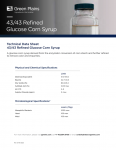The push for PHA: How Mad Tea’s compostable pods shift packaging standards

Genecis Bioindustries provides bioplastic solutions to multinational companies like Amazon, Novo Nordisk and Sodexo, and developing Mad Tea brings more attention to compostable packaging in commercial products, Yu said.

“While we were working with a lot of the CPG companies, we realized that we really had to launch our own products to … accelerate the world’s adoption and recognition of sustainable plastics,” Yu said.
The brand’s Nespresso-compatible pods are available in Matcha, Chai, Jasmine Milk Tea, Earl Grey, Chamomile Lavender, Thai Milk, Brown Sugar Milk and Peach Oolong, and are vegan and lactose-free.
Reaching 100% PHA can take ‘another one or two years’
Mad Tea’s packaging goal is to develop pods made with 100% PHA that are compostable at home which is expected to take “another one or two years,” Yu said. The pods' current blend of PHA and other compostable bioplastics can be industrially composted, Yu added.
“It really is just being able to achieve more economies of scale at this point and be able to really reach more people with our products, so that we can [reinvest] the revenues that we make – much like how Tesla does – and put it back into R&D as well as scaling so that we can continuously reduce the cost of production. If we can do that, then we can replace more and more of it with PHAs,” Yu said.
Currently, Mad Tea toll manufactures the production of its PHA plastics and its pods. The company plans to vertically integrate its production in the future which “can probably bring down production costs immediately by … 50%,” Yu said.
For brands adopting bioplastics for their packaging, it is important to introduce a “product that people can really love” and performs well, Yu advised.
Yu continued, “It has to be something that consumers can already really integrate … without much issue.”
Creating solutions where consumers do not have to choose between sustainability and convenience also is worth considering, Yu said.
“At Genecis, we really aspire to design and make materials that can really take care of themselves. … It is almost against human nature to make something that is more sustainable but more cumbersome to use. So, we wanted to figure out a way to … have the path of least resistance to make something that people can enjoy in the easiest way possible,” Yu added.
What are the obstacles to scalable sustainable packaging?
Sustainable packaging adoption continues to grow, with multinational brands like The Coca-Cola Company introducing 100% recycled 20-ounce bottles for several soft drink brands or PATH Water offering reusable, recyclable aluminum bottles.
However, adopting biodegradable packaging solutions comes with challenges, Parker Bovée, research associate, Cleantech Group explained to FoodNavigator-USA.
Scaling bioplastics and other compostable materials face hurdles like limited production capacity. Coupled with conventional plastics’ “established infrastructure and economies of scale,” bioplastics remain in early stages of development, limiting companies from implementing such practices, according to Bovée.
“This limited capacity results in higher production costs, which are then passed down the supply chain, making it difficult for many companies, especially those operating on thin margins, to adopt sustainable alternatives,” said Bovée.
Widespread adoption of bioplastics is more than cost alone
Brands are looking to bioplastics beyond just improving sustainability profiles, Max Senechal, chief commercial officer of biotechnology and biopolymer manufacturer CJ Biomaterials, told FoodNavigator-USA.
“You want something that is bio-based renewable, but also more importantly, allows you to have better solutions for end of life” like industrial and home composting, Senechal said.
He added that biopolymers offer an alternative to recycling.
While cost remains a major barrier in adopting bioplastics, blending different biomaterials may offer a better quality and cost-effective solution, Senechal said.
“There is no silver bullet in terms of the ideal biopolymer that can replace everything. So you need to work with polylactic acid (PLA) [and] PHA together,” for instance, that provides “good performance at a reasonable cost,” he added. PLA is an industrially compostable bioplastic often used for food packaging and made from organic resources like corn starch or sugar cane.
Yet widespread adoption of biopolymers requires more than addressing cost. Ensuring compatibility with existing machinery, lamination and printing processes is critical, Senechal said.
“When you get involved in flexible packaging for snacks, for example … the resin cost is an important component. … There are quite a few steps involved in developing a film-based flexible packaging. They are laminated. … They are printed. And when you look at the total cost stack, sometimes resin can be a third to a quarter of the total cost,” he explained.
Senechal continued, “Then the real question becomes: Can the biopolymers actually be used and perform well in the … the machinery that is used to make these multi-layer systems? Can it be printed on?”
A lack of clarity around “basic regulation” on permissible packaging types, combined with confusion about composting and recycling infrastructure, prevents rapid scale-up and adoption of these materials and solutions, he added.
Finally, conventional plastics do not reflect their full environmental cost, as society bears the expense of pollution cleanup and health impacts, Senechal explained.
Contrastingly, biopolymers offer more sustainable end-of-life solutions, yet face a disadvantage in the market since traditional plastics remain cheaper due to these hidden costs, he said. Regulation to level the economic playing field and account for these factors could further support biopolymer adoption, he added.



















